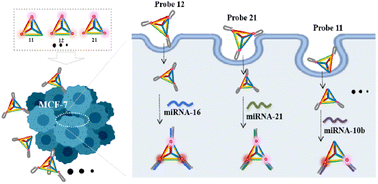Fluorescence intensity coded DNA frameworks based on the FRET effect enable multiplexed miRNA imaging in living cells†
Abstract
miRNA analysis has played an important role in precise diagnosis, treatment and prognosis of cancer, especially multiplexed miRNA imaging. In this work, a novel fluorescence emission intensity (FEI) encoding strategy was developed based on a tetrahedron DNA framework (TDF) carrier and the FRET effect between Cy3 and Cy5. Six FEI-encoded TDF (FEI-TDF) samples were constructed by tuning the labeling number of Cy3 and Cy5 at the vertexes of the TDF. For fluorescence characterization in vitro, distinct FEIs in the spectra and different colors under ultraviolet (UV) irradiation of FEI-TDF samples were observed. By dividing the ranges of FEIs of samples, the stability of FEIs was highly improved. Based on the ranges of FEIs in each sample, five codes with good discrimination were finally developed. Before the application of intracellular imaging, the excellent biocompatibility of the TDF carrier was proved by CCK-8 assay. The barcode probes based on samples 12, 21 and 11 were designed as example models to realize multiplexed imaging of miRNA-16, miRNA-21 and miRNA-10b in MCF-7 cells with obviously different fluorescence merged colors. FEI-TDFs provide a new research perspective for the development of fluorescence multiplexing strategies in the future.



 Please wait while we load your content...
Please wait while we load your content...